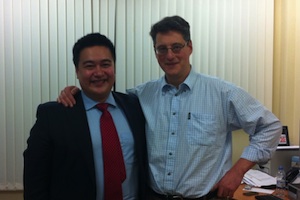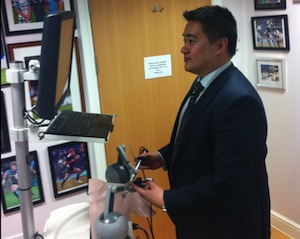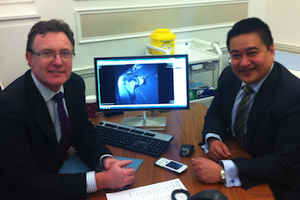My Experience as the 2011/2012 Travelling Fellow
Adrian J Carlos
I visited three Watanabe Club members, Julie McBirnie in Edinburgh, Len Funk in Wrightington, and Andrew Wallace in London spending a week with each host. All three are renowned UK Shoulder surgeons and I am very grateful for the precious time and generous hospitality they afforded me.
It was a fantastic opportunity to get advice from very experienced and established Shoulder surgeons and see them at work. My general aims for the Fellowship were not only to learn specific techniques from each expert but also to learn how they developed and managed their practice. At the stage of my career, it was invaluable experience, gaining information about what they would do (or would have done differently) if they were about to start their consultant career again.
I gathered an enormous amount of tips and tricks in the short amount of time I spent with each host. The most useful things I learned were, not only the expertly demonstrated arthroscopic techniques that one might expect, but also reasoning behind why they used the implants and instruments they had, and how their databases, working templates and practices are set-up. It’s these “little” things that as a senior trainee you start to pay attention to, as it becomes so much more relevant when you’re on the verge of becoming the responsible consultant.
I would advise all trainees to collate instrumentation lists and specific physiotherapy protocols from their subspecialist interest attachments as you will then have a better idea of which combination you would use when you have to set up your own practice.
The first and only real hurdle was in deciding which experts to see during my term. There are over 30 members to choose from nationwide and the process was almost impossible, I made my choices and was certain I could not be disappointed.
I had a fantastic time as the Fellow, and cannot possibly list everything I had experienced but the following are highlights from each visit:
My first trip took me to Scotland, the beautiful city of Edinburgh, to visit Julie McBirnie.
Picture 1. Julie McBirnie

Her work is mainly based at the Royal Infirmary Edinburgh and her practice involves both Shoulder and soft-tissue Knee Surgery. She completed a Fellowship in Toronto with Anthony Miniaci, and runs an Upper Limb Fellowship in her own unit.
She kindly set up the week I visited to consist of mainly shoulder arthroscopic procedures but I also had the pleasure of seeing her work in shoulder arthroplasty.
Among the numerous techniques, I was shown a repair of a large rotator cuff tear many would deem irreparable using and incorporating the long head of biceps tendon and complex primary total shoulder arthroplasty in a patient with significant glenoid wear. X-rays were taken on the same day showing perfect placement of the implant, anatomically reconstructing the geometry of the native joint.
I also sat in her clinics and took note of her impressively slick shoulder examination technique (something all aspiring shoulder surgeons should see). She had tremendous rapport with her patients, communicated very well and you could see satisfied patients walking out having good understanding and been involved in their management plans. I was also shown the merits of a well-run pre-admission clinic.
I was invited to a clinical conference to discuss difficult cases and was introduced to Edinburgh greats; McMaster, Court-Brown, McQueen and Robinson among many others in the forum.
I was very well looked after during my stay, we visited the fantastic Sheep Heid Inn in Duddingston, Edinburgh’s oldest surviving watering hole, for drinks after work. On the final evening, I was graciously invited for a delicious home-cooked dinner at her home to meet her wonderful family and friends.
My next visit took me to North England, Wrightington and Manchester, to visit Len Funk.
Picture 2. Len Funk

Wrightington Hospital needs no further introduction, rich in orthopaedic history and this year celebrating the Charnley Total Hip Replacement’s 50th anniversary. The Upper Limb Unit at the hospital includes 6 shoulder surgeons and currently has 6 Fellows. His practice is mainly arthroscopic and minimally invasive Shoulder surgery. He is a Professor at Salford University and treats many top sportsmen and women including international rugby players and premiership footballers.
Despite having an extremely busy working schedule, he managed to organise an action-packed week “off the cuff” (pardon the pun) for my visit.
Operative techniques shown include rotator cuff repair of massive tears made astonishingly seem simple and complex arthroscopic stabilisation including a master class on arthroscopic HAGL lesion repairs. As further testament to his organisational skills, he was able to show me operative videos of his previous HAGL repairs as he has compiled a library of all of his arthroscopic procedures. This was a fantastic learning tool not only for his trainees but also for himself, revisiting videos if and when needed.
I learnt a minimally-invasive technique to stabilise the dislocated sternoclavicular joint using a procedure devised by Mr Ian Trail. I was fortunate and also had the opportunity to see Mr Trail’s arthroplasty work in theatre whilst visiting the unit.
In clinic, patients were tremendously well informed with booklets and leaflets regarding their surgery, physiotherapy and even injections. Each patient was directed to the excellent website www.shoulderdoc.co.uk to learn more about their own condition. The website has helped me many times as a trainee and I highly recommend it as a broad resource for shoulder disorders and surgery. I was shown his clinical database and how his outcomes are all efficiently collected.
One of his educational interests involves simulator training. I had a go on the shoulder arthroscopy simulator and it was interesting to be graded on several routine arthroscopic tasks and procedures with feedback on efficiency of movement, accuracy and time taken to complete. It fast became quite addictive and was a fun way to train in a safe environment.
Picture 4. Simulator training

As mentioned, the unit had a number of Fellows who were mostly at a similar stage in their careers. It was great to share experiences, joining in on their activities including cadaveric workshops at the Wrightington’s Bioskills lab, being taken through approaches and specific techniques such as tendon transfers for cuff deficient shoulders. On several evenings, the Fellows along with Professor Funk and other Consultants, arranged drinks and meals at the famous “local” gastropub the Dicconson Arms.
I was fortunate enough to have timed my visit during the North West Shoulder meeting and was kindly invited to come along by Len Funk. I met the region’s Shoulder surgeons, and we discussed latest advances including experience with arthroscopic Latarjet stabilisation and a video demonstration of a recent procedure. It was also an excellent forum to discuss complex cases.
My final visit was to London to visit one of the original and founding members of the Watanabe Club. Andrew Wallace practices at the Hospital of St John and St Elizabeth’s and at the Fortius clinic in Central London.
Picture 5. Andrew Wallace

He has quite a unique practice of purely private work. His patients include elite professional athletes and celebrities alike. My visits to his clinic were a definite eye-opener, meeting an Olympic gold medallist for a primary consultation, followed by a telephone call consultation with arguably the most famous cricketer in the world, and then someone who I had only just seen on TV a few days ago walks in for a follow-up appointment. Definitely not what most would deal with on a day-to-day basis!
His patients therefore have high demands and/or high expectations. Despite this unusual workload and high pressure (to most), his operative technique was flawless and relaxed. In clinics, he manages to deal with each and every patient at their own level of understanding.
I was invited to see him operate at the King Edward VII hospital and I was shown a novel stabilisation procedure called the “Flying Swan” which results in a reinforced labral repair he developed with Susan Alexander, his wife and also member of the Watanabe Club. I was also shown and assisted in complex rotator cuff repair and proximal humeral fracture reconstruction.
On the final evening of my visit and Fellowship, I was invited to join Mr and Mrs Wallace to the Athenaeum Club at Pall Mall, for a sumptuous supper and a tour around this exclusive and historical institution which can boast a past and present membership of 52 Nobel Prize winners.
I would like to thank all three Host Consultants who not only gave precious time from their busy working schedules, allowing me to see how they work, but also took great effort to look after me during my tour. You can see why all three hosts have been so successful and it’s truly inspiring to see their work. I am extremely grateful to the Watanabe Club for an educational, eventful, and thoroughly enjoyable Travelling Fellowship.
Finally. . .
For all trainees reading this take heed, a Travelling Fellowship (particularly with an exotic name) is always interesting on the CV, and during my Consultant interview inevitably came up. It was a pleasant part of the interview and made me relax. In these days of strong competition for Consultant jobs, everything counts. I was one of the lucky ones, was successful on the day, and can now look forward to establishing my very own Arthroscopic Shoulder Surgery service.
Acknowledgements
I would also like to thank the following Shoulder surgeons and Watanabe members who have supported me throughout my career and helped me achieve my goals;
Steve Corbett, Steve Drew, Andy Cole, Andy Richards and Cameron Hatrick.